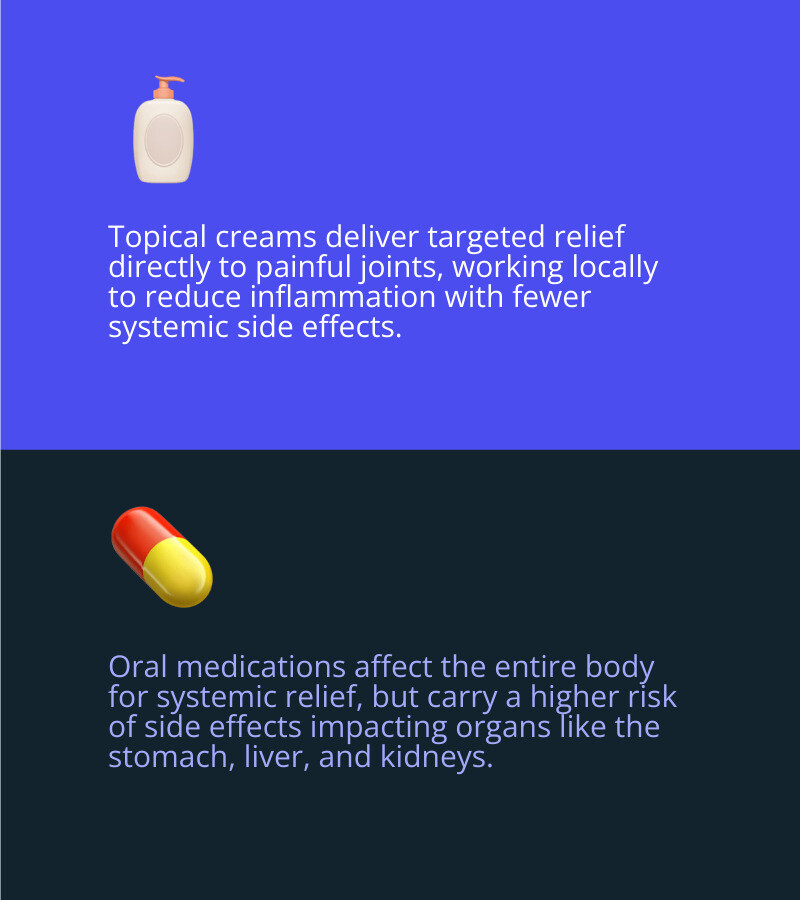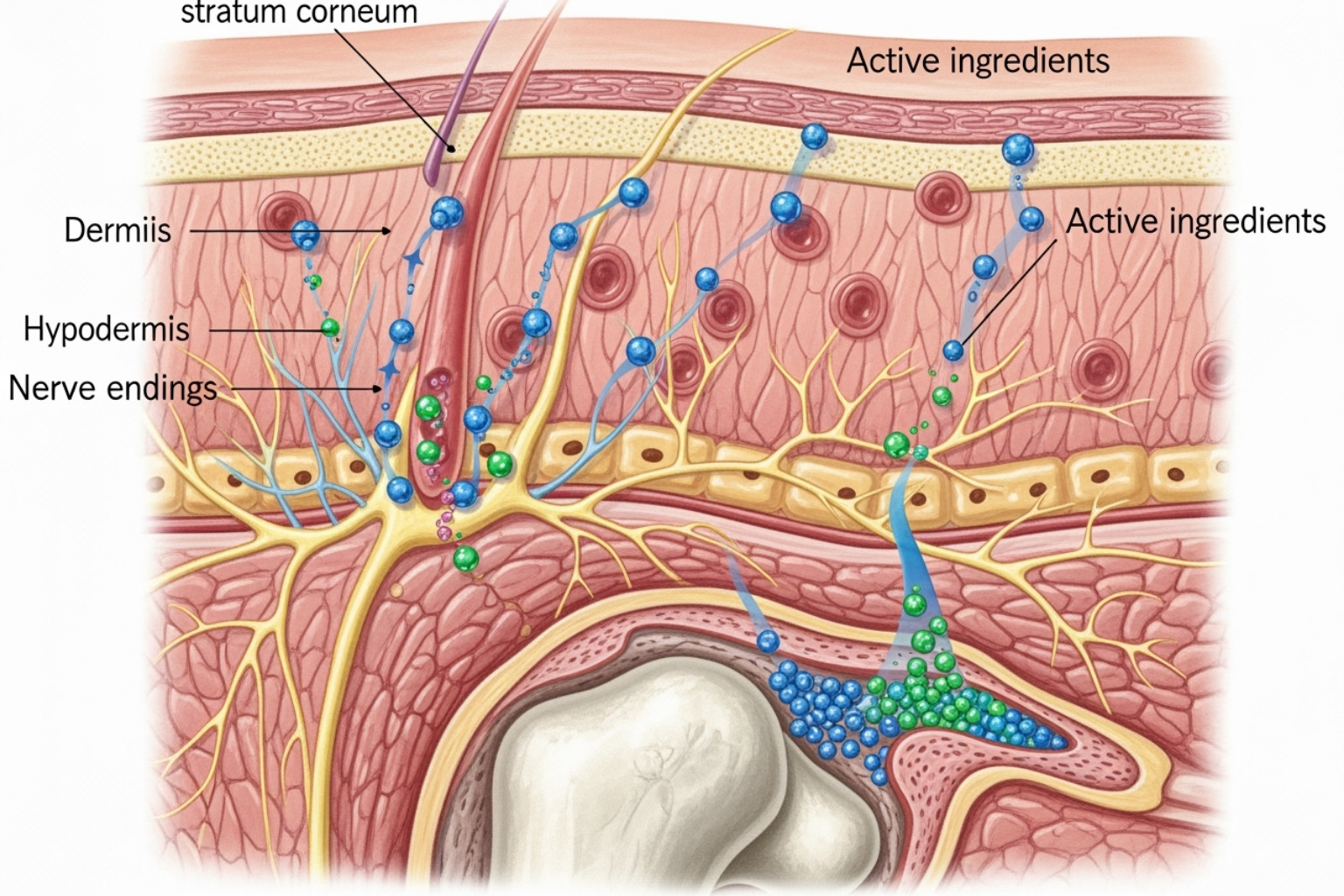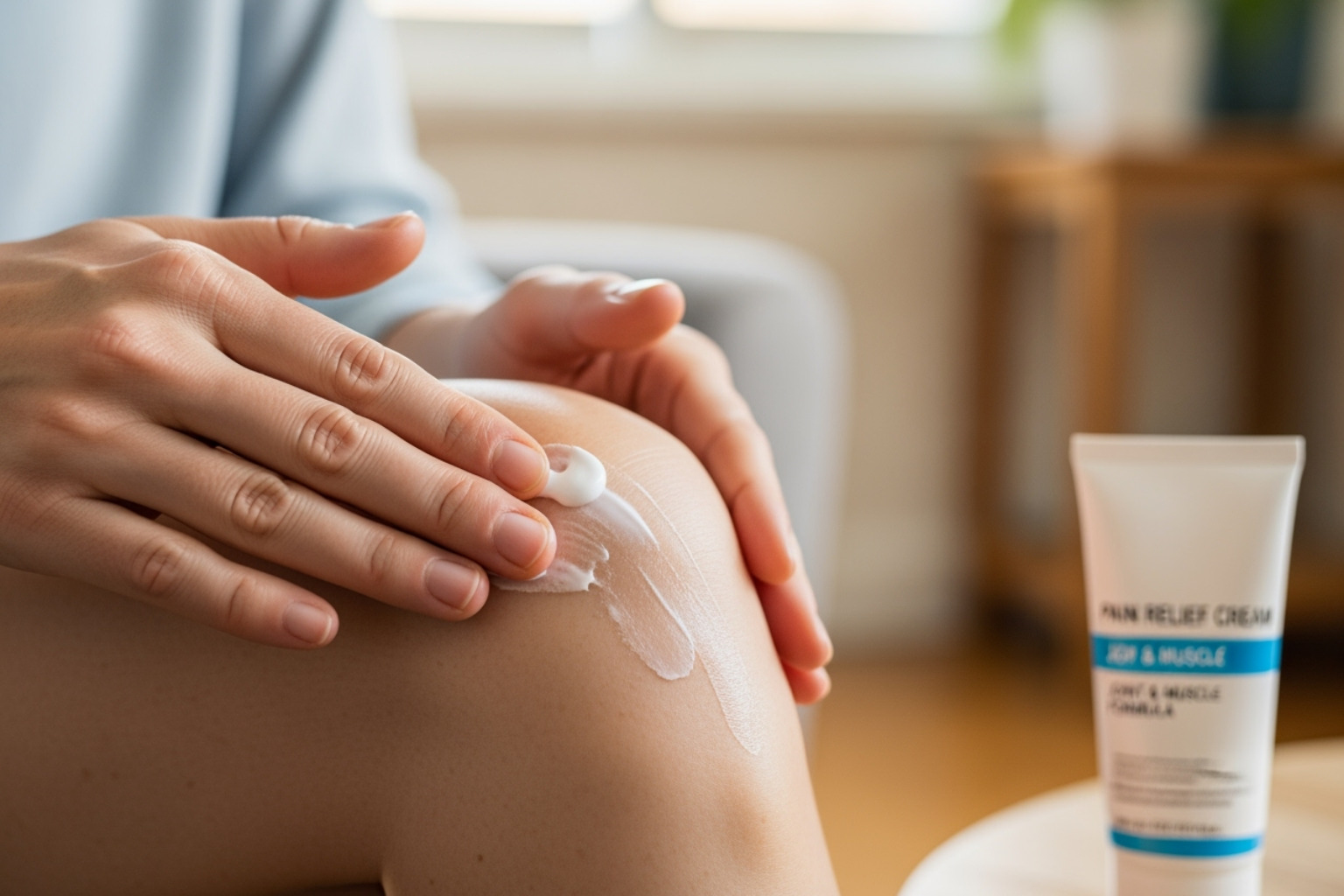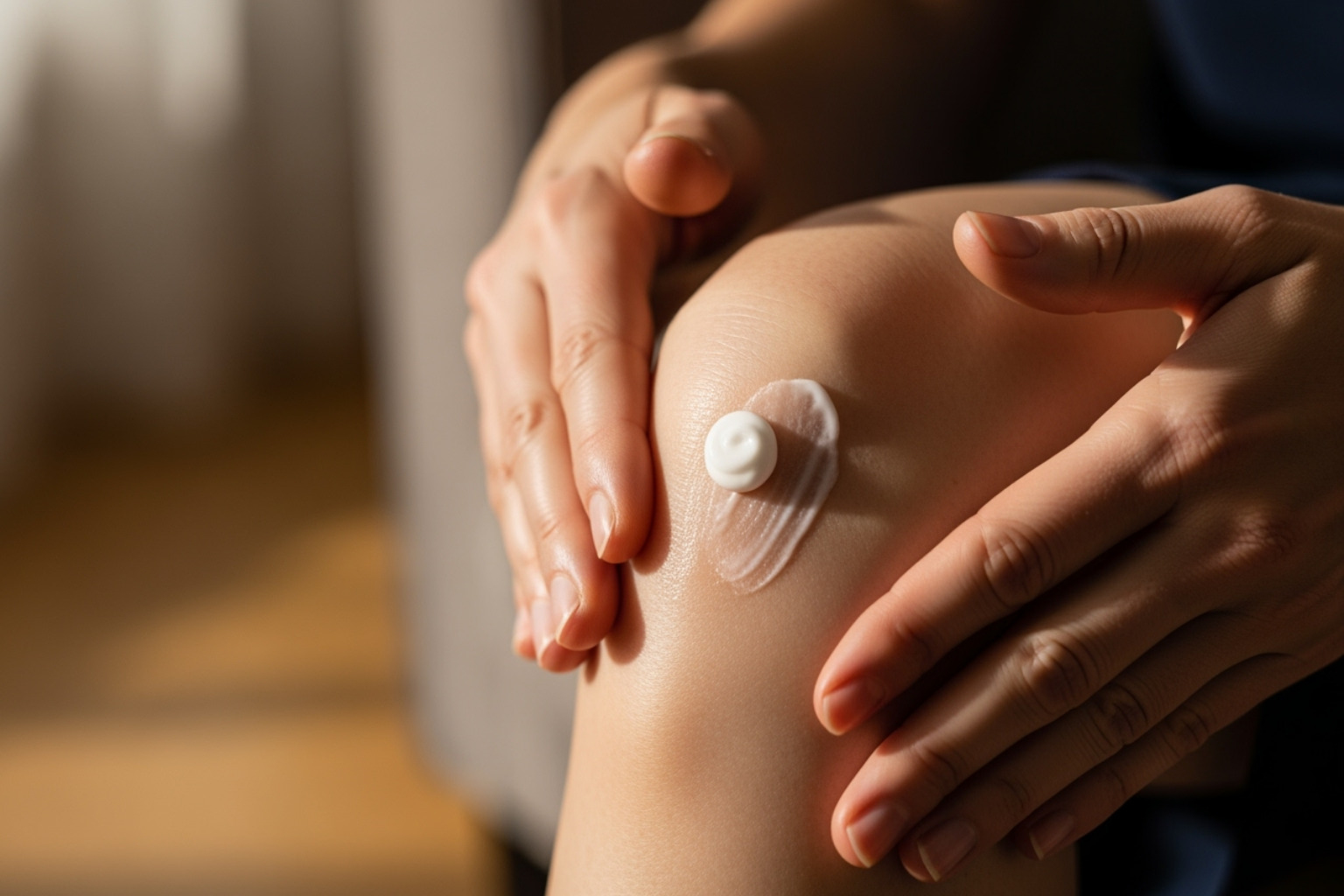Why Topical Pain Relief is Revolutionizing Joint Care
Cream for joint pain offers a targeted alternative to oral medications, delivering relief directly where you need it most. Unlike pills that affect your entire body, topical creams work locally to reduce inflammation and block pain signals at the source.
Key Benefits of Joint Pain Creams:
- Targeted relief - Applied directly to painful joints
- Lower side effects - Reduced risk of stomach, liver, or kidney issues
- Fast-acting - Many provide relief within 30 minutes
- Fewer drug interactions - Safer to use with other medications
- Best for surface joints - Hands, knees, wrists, and ankles
The science is clear: topical NSAIDs like diclofenac can work as well as oral NSAIDs for arthritis pain, but with significantly fewer systemic side effects. Research shows that topical treatments are particularly effective for joints close to the skin surface, making them ideal for hand arthritis and knee pain.
I'm Tony Enrico, and after years of working with athletes and individuals managing chronic pain, I've seen how the right cream for joint pain can transform a person's quality of life. Through my experience with Neuropasil's advanced formulations, I've helped countless people find the power of targeted topical relief.

Understanding the Science: How Active Ingredients in Creams Target Joint Pain
Ever wonder how a simple cream for joint pain can make your aching knees feel better? The science is fascinating. When you apply a pain relief cream, active ingredients penetrate your skin to reach the underlying tissues, nerves, and joints.
Unlike pills that travel through your entire digestive system, topical treatments work right where you apply them. This localized delivery system is why they shine for joints close to the surface—like your hands, knees, wrists, and ankles—where the ingredients can easily reach their target.

Menthol-Based Relief
Menthol creates an instant cooling sensation that provides immediate relief. It works through the gate control theory of pain: by stimulating cold receptors in your skin, it effectively closes the 'gate' to pain signals traveling to your brain. This counterirritant distracts your brain from the pain, providing a real physiological response. At Neuropasil, we've made menthol a cornerstone of our formulations for that immediate, soothing sensation our customers love.
For a deeper dive into this refreshing ingredient, check out our detailed guide on Menthol for pain relief.
Natural Soothing Ingredients
Beyond menthol's immediate effect, many creams include natural ingredients that support joint health and reduce inflammation more gradually.
- Aloe Vera: Brings legendary soothing properties, moisturizing the skin and making application more comfortable.
- Arnica: Used for centuries to reduce swelling and pain, this herbal extract helps calm inflammation naturally.
- Turmeric: Contains curcumin, a powerful anti-inflammatory compound that can reduce joint discomfort when applied topically.
- MSM (Methylsulfonylmethane): An organic form of sulfur that acts as a powerful antioxidant. It may help support cartilage function, as inflamed cartilage often has lower sulfur levels.
- Glucosamine: Naturally found in healthy cartilage, it's believed to help repair cartilage damage when applied topically, providing joints with essential building blocks.
These ingredients appeal to those seeking gentler, plant-based solutions. If you're dealing with tendonitis, learn more in our article on Cream for Tendonitis.
Nerve-Targeted Ingredients
Sometimes joint pain involves nerve signals. Certain ingredients specifically target these nerve pathways.
- Capsaicin: Derived from chili peppers, it creates a warming sensation. With repeated use, it depletes substance P, a chemical that transmits pain signals. It can take up to two weeks to work, but many find it effective.
- CBD (Cannabidiol): Has gained attention for its potential pain-relieving properties. It's thought to interact with the body's endocannabinoid system to reduce pain and inflammation.
- Lidocaine: A topical anesthetic that numbs the area by blocking pain signals at nerve endings. It doesn't reduce inflammation but effectively silences the pain.
Neuropasil's formulations address discomfort from various sources, including irritated nerves, using ingredients that work on these specific pathways. Find out how our approach targets multiple pain sources by visiting How Neuropasil targets nerve pain.
Topical vs. Oral Medications: The Benefits and Drawbacks
When dealing with joint pain, you can reach for a pill or a cream for joint pain. Both approaches have their place, but they work very differently.

Oral medications take a "whole-body approach," traveling through your bloodstream before reaching the source of pain. It's a thorough but indirect method. Topical creams are more like precision tools, applied exactly where it hurts for focused, direct action.
Benefits of Using a Topical Cream for Joint Pain
Through my experience with Neuropasil, I've seen why topical solutions are game-changers. The targeted relief is a primary advantage, delivering medicine directly to the problem area.
- Faster Relief: This focused approach often means quicker relief for localized pain in areas like the hands and knees.
- Lower Risk of Stomach Issues: Oral NSAIDs (ibuprofen) are known for causing stomach upset and ulcers. With topical NSAIDs (diclofenac), very little medication enters your bloodstream, sparing your stomach.
- Less Strain on Liver and Kidneys: Because they work locally, creams place a much lighter workload on the organs that process everything you ingest.
- Reduced Drug Interactions: Topical creams are less likely to interfere with other medications you may be taking.
- Ideal for Superficial Joints: They are most effective for joints close to the skin's surface, such as hands, wrists, knees, and ankles.
Drawbacks and Limitations
Topical creams aren't perfect. It's important to be aware of their limitations.
- Skin Irritation: Ingredients like capsaicin or menthol can cause redness, itching, or a burning sensation. Always do a patch test first.
- Allergic Reactions: If you have sensitivities to certain plants or ingredients, check the label carefully.
- Not for Deep Joints: Creams are less effective for joints buried deep under muscle, like the hip or shoulder, as the active ingredients can't penetrate that far.
- Requires Reapplication: You'll likely need to apply the cream multiple times a day to maintain relief.
- May Not Be Enough for Severe Pain: For intense or chronic pain, topicals are often best used as part of a broader pain management strategy rather than a standalone solution.
A Comparison of Neuropasil and Its Natural Ingredients for Joint Pain
When searching for the perfect cream for joint pain, the number of options can be overwhelming. After years in this field, I've learned that the most effective solutions often come from nature, but only when formulated correctly.
Natural ingredients offer a gentle yet powerful approach. Turmeric has soothed inflammation for thousands of years, while arnica has long been a trusted remedy for swelling. What sets an effective cream for joint pain apart is having the right natural ingredients working in harmony. At Neuropasil, we've carefully selected each component based on both traditional wisdom and modern science.
Our formula combines menthol for immediate cooling, aloe vera for skin comfort, arnica and turmeric to reduce inflammation, MSM for cartilage health, and glucosamine to support joint structure. Each ingredient has a unique mechanism, creating a comprehensive solution.
The Neuropasil Advantage
What makes our approach different? We don't just combine popular ingredients; we formulate them to work synergistically. Our cream for joint pain is designed to be more effective together than any single ingredient would be alone.
Customers rely on Neuropasil for a wide range of issues, from neuropathy and sciatica to arthritis and plantar fasciitis. Athletes use it for muscle recovery, and people with hand arthritis find it helps them regain function. This is the power of a multi-action formula.
We are committed to creating a product that is both fast-acting and non-greasy. Our formula absorbs quickly, won't stain clothes, and has a pleasant, refreshing scent. The versatility of Neuropasil comes from targeting both the immediate sensation of pain and the underlying inflammation. Why choose Neuropasil becomes clear when you experience this comprehensive approach firsthand.
How Neuropasil's Ingredients Work Together
The magic happens when these natural ingredients combine forces. Think of it as a team where each player has a specific role, all working toward the same goal: getting you back to feeling like yourself.
Menthol acts first, creating an immediate cooling sensation for relief within minutes. While you enjoy that comfort, turmeric and arnica get to work reducing inflammation and swelling at a cellular level. At the same time, MSM and glucosamine deliver crucial compounds that your cartilage needs for maintenance and repair. Throughout this process, aloe vera ensures the cream feels smooth and comfortable on your skin.
This synergy means you're not just masking pain—you're addressing it from multiple angles. The result is a cream for joint pain that helps you get back to enjoying life, with a non-greasy feel and pleasant scent that makes it a welcome part of your daily routine.
How to Safely Use and Choose the Best Cream for Joint Pain
Finding the right cream for joint pain and using it correctly can make all the difference. Even natural ingredients can cause reactions if used improperly. Correct application is key to finding relief.

Step-by-Step Guide to Safe Application
Follow these simple steps to get the most from your cream for joint pain safely and effectively.
- Read the Label: Every product has unique instructions. Some, like Voltaren Arthritis Pain Gel, even come with a dosing card for accuracy.
- Do a Patch Test: Before applying to a large area, test a small dab on your forearm and wait 24 hours to check for any reaction. This is crucial with capsaicin products or if you have sensitive skin.
- Apply to Clean, Dry Skin: Wash and dry the area first. Dirt and oils can interfere with absorption.
- Use the Correct Dose: More isn't better. Follow the product's specific dosing instructions for safety and effectiveness.
- Wash Your Hands: Immediately after application, wash your hands thoroughly to avoid accidentally touching your eyes, especially with menthol or capsaicin creams.
- Avoid Broken or Sensitive Skin: Never apply these creams to cuts, scrapes, rashes, or near your eyes and mouth.
- Skip the Extra Heat: Do not use heating pads or tight bandages over the cream, as this can increase absorption and cause skin reactions or burns.
How to Choose the Right Cream for Joint Pain
With so many options, matching the formula to your needs is key.
- Consider Your Pain Type: For inflammatory pain (swelling, warmth), look for topical NSAIDs (diclofenac) or natural anti-inflammatories like turmeric, arnica, and MSM. For nerve-related pain (shooting, tingling), consider capsaicin, lidocaine, or comprehensive formulas like Neuropasil.
- Think About Location: Topicals work best on surface joints like hands, knees, and wrists. Deeper joints like hips may require other treatments.
- Know Your Skin: If you have sensitive skin, you may prefer gentler, odor-free formulations over those with high concentrations of menthol or capsaicin.
- Natural vs. Pharmaceutical: This often comes down to personal preference. Pharmaceutical NSAIDs like diclofenac (Voltaren) are well-researched for arthritis, while many prefer the gentler approach of natural, plant-based blends.
Integrating Creams with Other Pain Management Strategies
A cream for joint pain works best as part of a bigger picture. A holistic strategy often yields the best results.
- Exercise: Topical relief can make movement more tolerable, allowing you to benefit from exercises that strengthen joints. The Mayo Clinic recommends combining topical treatments with prescribed exercises for conditions like knee osteoarthritis.
- Weight Management: Reducing weight takes significant pressure off joints like the knees. Creams can provide the comfort needed to stay active while pursuing weight goals.
- Lifestyle Adjustments: With pain under control, it's easier to make ergonomic changes or modify activities to protect your joints.
- Medical Guidance: Always consult your doctor for persistent pain to get an accurate diagnosis and a comprehensive management plan.
For more on building a comprehensive plan, explore our guide: Managing Arthritis Pain: A Guide to Long-Lasting Relief.
Frequently Asked Questions about Joint Pain Creams
Choosing and using a cream for joint pain can raise many questions. Here are clear answers to some of the most common ones I've encountered while helping people find relief with Neuropasil and other topicals.
What are the potential side effects of using these creams?
Topical creams are generally gentler than oral medications, but some reactions can occur, mostly at the application site.
- Skin Irritation: This is the most common side effect, appearing as redness, mild itching, or a rash. Capsaicin creams cause a warming or burning sensation, which is part of how they work. Menthol-based products like Neuropasil create a cooling sensation that most find soothing.
- Allergic Reactions: Though less common, these can happen. If you have an aspirin allergy, consult your doctor before using creams with salicylates. A patch test is always recommended to check for sensitivity to plant-based ingredients.
- Systemic Risks: These are rare but not impossible. Small amounts of NSAID creams (like Voltaren) can be absorbed into the bloodstream. Read warning labels carefully, especially if you have heart, liver, or kidney disease.
Stop using a cream and consult your doctor if irritation worsens or pain doesn't improve after the recommended trial period (often one week).
How long does it take for a pain relief cream to work?
The time it takes depends on the active ingredients.
- Menthol-based creams (like Neuropasil or Icy Hot) offer an immediate cooling sensation within minutes. This provides fast relief by distracting your brain from pain signals.
- NSAID creams (like Voltaren) reduce inflammation. You may feel some relief in 30 minutes, but they often require up to a week of consistent use for their full effect on arthritis pain.
- Capsaicin creams require the most patience. They work by desensitizing nerve endings, a process that can take up to two weeks of regular use. Stick with it for at least 10-14 days before judging its effectiveness.
Consistency is crucial for most topical pain relievers.
Can I use joint pain creams if I'm pregnant or have other health conditions?
Always talk to your doctor first. This is non-negotiable when it comes to pregnancy or serious health conditions.
- Pregnancy and Breastfeeding: Many creams carry warnings. NSAID-containing creams are generally not recommended during the third trimester.
- Underlying Health Conditions: If you have heart disease, high blood pressure, liver or kidney problems, asthma, or a history of stomach ulcers, get your doctor's approval before using any pain relief cream, especially NSAID topicals.
- Allergies and Drug Interactions: If you have an aspirin allergy, avoid salicylate creams without medical clearance. Also, consult your doctor if you take blood thinners, as some topicals could interact with them.
Your healthcare provider can offer personalized advice based on your complete medical history.
Conclusion: Finding Your Path to Targeted Relief
Joint pain doesn't have to control your life. A cream for joint pain offers a targeted approach to managing discomfort, focusing relief exactly where you hurt without affecting your entire body.
We've explored the science, from menthol's cooling distraction to the anti-inflammatory power of ingredients like turmeric and arnica. Natural compounds like MSM and glucosamine work in harmony to support cartilage and joint tissue. This targeted nature means fewer side effects, less strain on your organs, and often faster relief for surface joints like your hands and knees.
At Neuropasil, we've built our reputation on this balance of natural effectiveness and scientific backing. Our formulation creates a symphony of relief: menthol provides immediate soothing, while aloe vera, arnica, MSM, and turmeric work together to calm inflammation and support your joints.
However, the best results come from a holistic approach. Your cream for joint pain is a powerful tool that works even better when combined with gentle exercise, healthy lifestyle choices, and guidance from your healthcare provider.
The beauty of natural, multi-action formulations like ours is that they address multiple aspects of pain simultaneously. You're not just masking symptoms—you're supporting your body's healing processes while getting the immediate relief you need to stay active.
Targeted topical relief offers a gentler path forward. The key is finding a product that combines fast-acting ingredients with long-term joint support—exactly what we've designed Neuropasil to deliver.
Ready to experience the difference that natural, fast-acting relief can make? Explore our natural, fast-acting creams for targeted pain relief and find why thousands trust Neuropasil for their pain management needs.
Your journey to better joint comfort starts now. Take control and move freely again.














